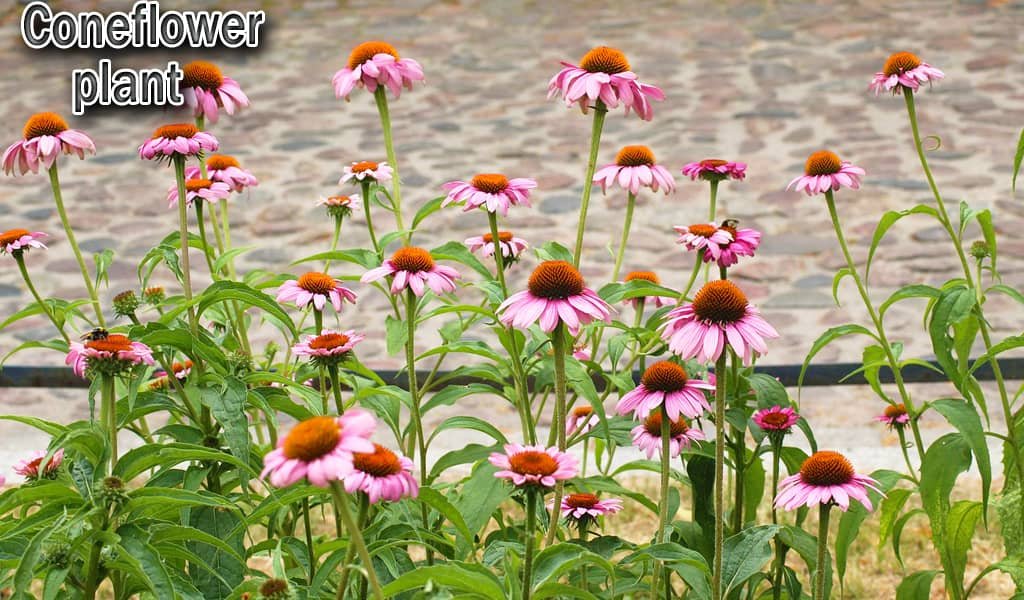Coneflower is a genus of herbaceous flowering plants in the daisy family, also commonly known as Echinacea. This plant is mostly found in eastern and central North America. The name coneflower is derived from the Greek word ἐχῖνος (ekhinos), meaning “hedgehog” because of its prickly center. Some parts of this coneflower plant are also used as medicine, and the best time to plant them is spring. This plant can be found in forest areas.
A coneflower is a flowering plant with yellow, white, pink, and red flowers that look like a spherical ball with a spike in the center and surrounded by petals. This plant has long and slightly broad leaves which are green in color. This plant is also used to make medicine and improve health. Echinacea purpurea and purple Coneflower are the best known varieties. These flowers have good juice, so they are preferred by bees and butterflies.
Content summary:
- What is Coneflower
- History of Coneflower
- Most Interesting Facts
- Types of Coneflower
- Growing Coneflower at Home?
- How to Care
- Protect Against Pests and Diseases
- Related Questions
- Other names of Coneflower
- Uses of Coneflower
History
Coneflower is a plant that originates from North America and is used by the local Indians there. The archeological department around the 18th century found the first evidence of this plant . This coneflower name includes several species of the Asteraceae family.
Coneflower Overview
- Botanical Name: Echinacea purpurea
- Common Name: Purple coneflower
- Family: Daisy
- Plant Type: Herbaceous perennial
- Bloom Time: Summer
- Soil Type: Well-drained
- Soil pH: Neutral to acidic
- Sun Exposure: Full sun, partial shade
- Mature Size: 2–5 ft. tall, 1–2 ft. wide
- Hardiness Zones: 3-8 (USDA)
- Plant Flowers Color: Purple, pink
- Native Area: North America
Types of Coneflower
[1] Firebird (Echinacea ‘Firebird’)
Firebird has attractive orange or red flowers that are round in shape. The Firebird was developed in Oregon in 2009. The leaves of this plant are green. The best time to sow this plant is spring, and the flowers bloom during autumn.
- Sun Exposure: Full sun
- USDA Growing Zones: 4 to 9
- Height: 24 to 36 inches
- Native Area: United States
[2] Greenline (Echinacea purpurea ‘Greenline’)
The name Greenline itself suggests that it is full green in color and looks like a light. This is a type of coneflower whose flowers bloom from spring to late summer. This plant flowers on stems 15-24 inches tall.
- Sun Exposure: Full sun
- USDA Growing Zones: 3 to 8
- Height: 18 to 24 inches
- Native Area: United States
[3] Leilani (Echinacea ‘Leilani’)
The Leilania plant has yellow flowers that bloom on a long stem, and the flowering period is from July to October. This plant adapts to poor and moist soil. This plant is native to North America. It is a center of attraction for butterflies and bees.
- Sun Exposure: Part sun
- USDA Growing Zones: 4 to 9
- Height: 36 to 42 inches
- Native Area: United States
How to Grow
- Use a container with drainage holes so excess water drains out
- Add compost and organic nutrients to this plant’s soil
- Water the plant when the top 1-inch is dry, and water regularly
- Keep the container of this plant in the shade and take it out into the sunlight during the morning.
- Temperatures for this plant should be between about 40º to 50ºF for cool areas and between 60º to 70ºF for warm regions.
How to Care
Coneflowers grow well in USDA hardiness zones four through ten. This plant has to be protected during the first winter as it does not tolerate too much cold. We can make new plants by growing these plants well from seeds. This plant is used to beautify the garden.
Light
Coneflowers generally prefer shade. This plant needs at least six to eight hours of light daily for faster growth and better flowering. This plant can tolerate partial light.
Soil
Coneflower grows best in the garden and on the ground. The plant grows fast and grows well in rocky and sandy soils. Coneflowers generally prefer soil with a neutral pH between 6.5 and 7.0. This plant likes moist and moist soil. Add fertilizer and essential nutrients to the ground while planting this plant.
Water
Coneflower is a plant with drought-tolerant nature. After planting this coneflower plant, water it four to five times weekly to establish it. After a year, it won’t need to water it much. Water this plant only when the soil is dry, and give 1 liter of water when watering.
Fertilizer
Fertilize your coneflowers before spring for the best blooms and good growth. Fertilizing coneflowers more than they need can harm them. The flowers of this plant will not bloom with artificial fertilizers called Roethling.
Temperature and Humidity
A coneflower is a plant that thrives in hot and dry climates. The temperature required for this plant should be around 70 to 75°F (21 to 24°C). It prefers a humid environment where the soil stays moist.
Common Pests/Diseases
Various species of coneflowers suffer from diseases and pests, most of which survive, such as aphids, anthracnose, aster yellows, Japanese beetles, fusarium wilt, eriophyid mites, leaf spots, powdery mildew, leafhoppers, and stem rot. You can use an insecticide or neem oil to treat this coneflower.
FAQ
[1] Other names for Coneflower
Coneflower is a species of flowering plant in the Asteraceae family that includes eastern purple coneflower, hedgehog coneflower, Echinacea purpurea, and echinacea.
[2] What is coneflower used for?
Coneflower is an herbal medicine that people have used for centuries to treat coughs, bronchitis, colds, and upper respiratory tract infections.
[3] Can you eat coneflower?
Coneflower is also considered safe for human consumption.

